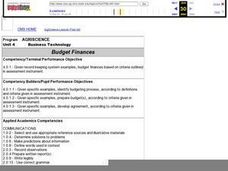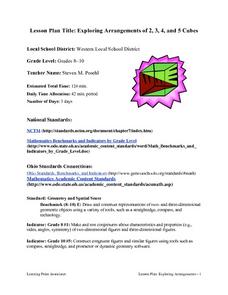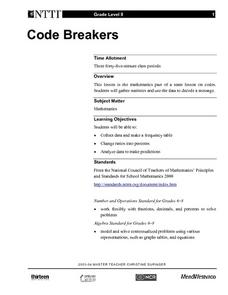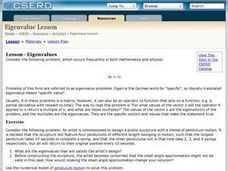PBS
Could You Start a Business?
High schoolers learn how a business starts and finds financial independence. For this lesson, students learn the struggle of financial management, the costs of running a business and how to keep a budget.
Curated OER
System of Two Quadratic Inequalities
Students graph a quadratic inequality and describe its solution set. They solve a system of quadratic equalities graphically and symbolically and as related to a real-world context.
Curated OER
Introduction to Fractions
Fourth graders break into groups having 10 come to the front and figure out the fraction of students are wearing jeans, glasses, have brown hair, etc. They write the fraction together. Each student then makes a picture and be able to...
Curated OER
Geo Jammin' By DeSign - Day 1, Lesson 2: Dancing Duo
Second graders and teachers identify geometric vocabulary word by searching a geometry website. They create a Quilt Word Wall using the geometry words.
Curated OER
Making Shapes
Tenth graders construct geometric figures using compasses and protractors.
Curated OER
Budget Finances
Students role play the role of a recent graduate of high school living on their own. Using play money, they are given one month's salary and they discover they own their own house or apartment and owe money on a car loan. They develop...
Curated OER
Symmetries of Strip Patterns
Students study strip patterns and identify symmetry. They create a paper doll chain. They experiment with different shapes. They determine if their chain is a strip pattern. They create snowflakes with triangles.
Curated OER
Tessellation Quilt Squares
Fifth graders design a "quilt block" that has a tessellating pattern to help create a class tessellation quilt. They describe relationships between two- and three-dimensional shapes and analyze attributes and properties of geometric...
Curated OER
Finding the Salt Front
Students discuss definitions of estuary, salinity, and the salt front. They listen as the teacher explains the Hudson River Miles and ways the upriver and downriver sections relate to the north and south. Students graph the salt front...
Curated OER
Area of Parallelograms
Seventh graders review the process of finding the area of a rectangle and complete a couple of examples as a class. They discuss what a parallelogram is and what the formula would be for finding its area. They listen to an explanation...
Curated OER
Exploring Arrangements of 2, 3, 4, and 5 Cubes
Students construct models of various tricubes, tetracubes, and pentacubes that are possible, classify n-cubes into different groupings, and draw these figures on isometric dot paper giving true perspective to what they visualize.
Curated OER
Code Breakers
Young scholars collect data and make a frequency table, change ratios into percents, and analyze data to make predictions.
Curated OER
Fast Food Survey Using Bar Graphs
Second graders conduct survey and sort data according to categories, construct bar graph with intervals of 1, and write a few sentences about their graphs.
Curated OER
Multiplication Slideshow
Students create a slideshow of multiplication facts using Keynote. Students create slides with a multiplication fact and a picture representation for the multiplication facts from 2 through 5.
Curated OER
Tessellating Art
Fourth graders create artwork showing their own unique tessellating shapes. They apply the symmetries of a regular polygon and describe the reflection or rotational symmetry of a figure or object. They share their art work with the class.
Curated OER
Strawberry Milk
Pupils work in groups or alone to solve the problem. They use a systematic approach to get all possible answers. They report back to the class with solutions. They may extend their studying using a crate with room for 9 bottles.
Curated OER
Mum's Kitchen Floor
Students discuss patterns on a chess board examining symmetries. They read the problem and then brainstorm for ways to solve the problem. As they complete the floor pattern, they record symmetries that it contains.
Curated OER
System of Two Quadratic Inequalities
Pupils set up and solve a system of quadratic inequalities related to real-world situations.
Curated OER
Mammoth Sunflower Problem
Students discuss the directions on a package of seeds. They open the package, count the seeds, and determine the planting requirements for the seeds.
Curated OER
The Box Problem
Students investigate the concept of functions and how they are used with polynomials. They practice finding the zeros of functions and graph polynomial functions for the help of giving solutions. Students interpret the curve of a line...
Curated OER
Getting to the Bottom of the Pyramids
Learners work together to develop logical arguments about pyramids and chain letters. They share their ideas with other groups and create a diagram showing the breakdown. They discuss the results.
Curated OER
Physics: Eigenvalues
Students solve problems by discovering the eigenvalues that satisfy design questions. They explain how relaxing a small angle approximation can change the solution. Students apply the numerical model of pendulumm motion to solve the...
Curated OER
The Tiled Courtyard
Fifth graders use the guess and check technique to solve a problem involving transformations. They work with a grid and criteria provided by the teacher to solve a sequence with black and white rows.

























